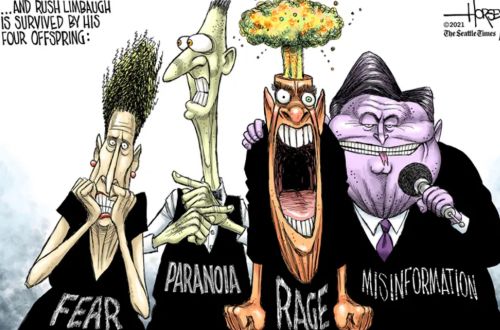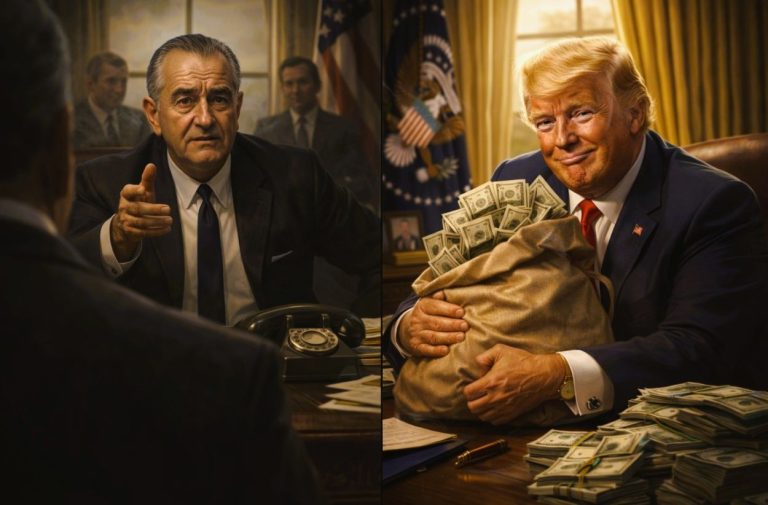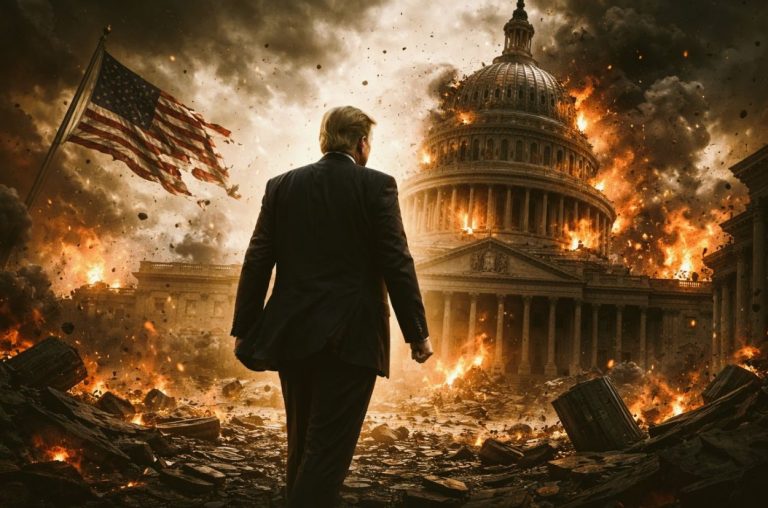

What began as entertainment on the airwaves evolved into apocalyptic cable sermons, then into presidential incitement, and finally into a youth movement fueled by digital virality.

By Matthew A. McIntosh
Public Historian
Brewminate
Introduction
In the United States, political rhetoric has always carried heat, but over the past three decades it has taken on a sharper edge, one that flirts openly with violence. Words that once lived on the margins of talk radio have migrated into the mainstream, repeated across cable news, presidential podiums, and campus rallies. The transformation has been gradual but relentless: a style that began as provocative entertainment has hardened into a political culture where violent imagery is no longer taboo but part of the everyday script.
Rush Limbaugh pioneered the model, perfecting the art of ridiculing opponents while encouraging listeners to see politics as a battle against enemies rather than a contest of ideas. Glenn Beck brought apocalyptic flair, sketching conspiracies on a chalkboard that cast fellow citizens as sinister threats plotting America’s downfall. Donald Trump elevated this language from media theater to statecraft, openly urging supporters at rallies to rough up protesters and later presiding over a violent insurrection. And Charlie Kirk, the youngest of the group, packaged the same ethos for a generation raised on social media, framing aggression as the natural expression of patriotism.
Taken together, these figures chart a trajectory of escalating incitement: from mocking caricature to conspiracy, from rally-stage threats to digital-age normalization. Their words do not stand in isolation. They accumulate, repeat, and resonate, turning violent suggestions into political common sense, and blurring the line between rhetorical provocation and physical action.
Rush Limbaugh: The Talk Radio Blueprint
Rush Limbaugh was not the first talk radio host to lace political commentary with rage, but he was the one who turned it into a cultural juggernaut. For more than three decades, his voice reached millions daily, blending humor, contempt, and a steady undercurrent of menace. What made Limbaugh so effective was not just his political positions but the way he reframed disagreement as enmity. Liberals weren’t simply wrong; they were “feminazis,” “commie pinkos,” or parasites destroying America from within.
This rise was made possible by a critical regulatory shift. In 1987, the Federal Communications Commission repealed the Fairness Doctrine, which required broadcasters to provide balanced coverage of controversial issues. With that guardrail gone, radio hosts no longer had to present counterarguments or opposing voices. Limbaugh seized the moment, filling the airwaves with a one-sided barrage of grievance and mockery. The repeal gave him not just space but dominance, allowing his style to thrive without the obligation of balance, and it cemented talk radio as a partisan weapon rather than a public forum.
This wasn’t policy analysis; it was theater. Limbaugh perfected the cadence of insult as entertainment, his mocking tone giving listeners permission to indulge anger without apology. Violence was rarely spelled out, but it was constantly implied in the posture he encouraged: that opponents were enemies, that compromise was surrender, that to “take back the country” meant treating politics as war. By insisting that America was under siege from cultural and political elites, he stoked the idea that resistance could not be merely rhetorical.
The impact rippled far beyond his broadcast booth. Limbaugh’s language created a blueprint for an entire media ecosystem built on outrage, one where audience loyalty was tied not to facts but to shared hostility. His words encouraged listeners to see themselves not as citizens in a democratic debate but as soldiers in a cultural conflict. That framing—the sense that politics is combat, not conversation, laid the groundwork for more explicit calls to aggression that would follow.
Glenn Beck: The Chalkboard Prophet
If Limbaugh’s stage was the radio booth, Glenn Beck’s was the Fox News studio, and his chalkboard became the most notorious prop in cable news. At the height of his influence in the late 2000s, Beck offered his audience a vision of America on the brink, connecting dots between politicians, activists, and shadowy forces in sprawling conspiratorial diagrams. His style was part preacher, part doomsayer, part history teacher gone rogue, and it resonated with viewers already primed by talk radio to see politics as a battlefield.
Beck’s rhetoric leaned heavily on apocalyptic imagery. He warned of government plots to enslave citizens, financial collapse orchestrated by elites, and cultural decay driven by hidden enemies. His message was rarely subtle: stock up on gold, prepare for chaos, brace for tyranny. This constant drumbeat of catastrophe invited not just skepticism of government but readiness for confrontation. In Beck’s telling, America wasn’t merely divided—it was under siege, and patriotic citizens had to steel themselves for resistance.
That framing helped fuel the Tea Party movement, which Beck championed, and which often flirted with violent imagery in protests and placards. Militias and survivalist groups saw in his broadcasts a form of validation, a cable-news endorsement of their worldview. Though Beck later tried to temper his message, even expressing regret about some of his harsher rhetoric, the damage was lasting. He had taken Limbaugh’s politics-as-combat model and infused it with apocalyptic urgency, mainstreaming the idea that the Republic could fall at any moment and that extraordinary measures might be justified to save it.
After leaving Fox in 2011, Beck launched his own platform, The Blaze, hoping to carry his audience into the digital age. But as his influence waned, he began to acknowledge publicly that his earlier style had gone too far. In interviews, he admitted he had contributed to division and sought to present himself as a more reflective, even repentant, figure. Yet the movement he helped energize did not follow him into moderation. His chalkboard diagrams and warnings of collapse outlived his mea culpas, echoing across social media and right-wing forums where the rhetoric of siege and survival still thrives.
Donald Trump: The Rally Stage
Where Rush Limbaugh mocked and Glenn Beck warned, Donald Trump commanded. From the moment he descended the golden escalator in 2015, Trump fused the language of spectacle with the authority of politics, bringing the cadence of reality television into campaign rallies and later into the White House. What distinguished him was his willingness to say the quiet part out loud. At rallies, he urged supporters to “knock the crap out of” protesters, promised to cover legal fees for assaults, and praised physical aggression as patriotism in action. Unlike Limbaugh or Beck, he wasn’t just an entertainer; he was the Republican frontrunner, then the president of the United States.
Trump’s rhetoric blurred the line between metaphor and marching orders. His repeated insistence that journalists were “enemies of the people” echoed authoritarian scripts, painting the press not as watchdogs but as targets. His boasts that police should treat suspects “rough” and his praise for a congressman who body-slammed a reporter normalized the idea that violence was not only permissible but admirable. For his audience, violence was framed not as a breakdown of order but as a defense of America itself.
This escalation culminated in January 6, 2021. After months of telling supporters the election had been stolen, Trump summoned them to Washington with promises it would be “wild.” On the Ellipse, he delivered a speech urging the crowd to “fight like hell” or risk losing their country. Hours later, the Capitol was under siege. Though Trump would later try to distance himself from responsibility, the mob’s chants, “Fight for Trump!”, were the echo of years of encouragement that violence was the natural response to political loss.
Even out of office, Trump never dialed back his language. On the campaign trail in 2023 and 2024, he promised “retribution” against his political opponents, told audiences that a Trump loss would mean a “bloodbath” for the country, and increasingly cast political struggle as existential warfare. These lines were not slips, they were applause lines, greeted with cheers and chants that reinforced his role as both leader and instigator.
Now, in his second term as president in 2025, that rhetoric has not softened. Trump continues to frame dissenters as traitors, protesters as domestic enemies, and opposition leaders as threats to be “dealt with.” The difference is that his words no longer hover only in the realm of rallies or social media, they hang over the machinery of government itself. Where Limbaugh and Beck shaped atmospheres of anger, Trump wields the state from within that atmosphere, marrying rhetorical violence with executive power. The permission structure he established is no longer about bluster. It is about rules.
Charlie Kirk: The Youth Wing
If Limbaugh built the blueprint, Beck amplified it, and Trump weaponized it, Charlie Kirk became the movement’s youth ambassador, translating the rhetoric of confrontation into the idiom of Generation Z. As the founder of Turning Point USA, Kirk built a vast network of college chapters, social media channels, and live events that fused political messaging with the energy of pop culture. His reach was not confined to lecture halls. Podcasts, TikTok clips, and viral soundbites carried his words into the feeds of millions of young conservatives.
Kirk’s rhetoric was less theatrical than Beck’s chalkboard sermons or Trump’s rally tirades, but the substance carried the same undercurrent. He frequently framed Democrats and progressives not simply as political opponents but as existential threats to freedom, faith, and nation. His warnings of “civil war” and calls to resist “traitors within” were rarely outright directives to violence, but they served the same purpose Limbaugh and Beck once did: making hostility sound like common sense, an appropriate response to a country allegedly on the brink of collapse.
This framing was especially potent given his audience. Unlike Limbaugh’s older listeners or Trump’s broad base, Kirk spoke primarily to young people still forming political identities. His campus events encouraged jeering, mockery, and verbal confrontation, rewarding students who performed their politics as combat. Online, he packaged ideological warfare into memes and clips, the perfect currency for an algorithm that rewarded outrage. The result was a generation of conservatives tutored in the normalization of violent imagery, where the line between rhetoric and reality blurred.
That line ultimately blurred for Kirk himself. On September 10, 2025, he was murdered in an act of violence that starkly illuminated the dangerous ecosystem he had helped foster. The irony was impossible to miss: a man who spent his career normalizing the language of conflict and treating politics as a battlefield became a casualty of that very logic. His death underscored the central contradiction of rhetorical violence; it cannot be contained or controlled. What begins as provocation for clicks and cheers can return as real bloodshed.
But the lesson must not be twisted. Violence is never an acceptable answer to speech, no matter how provocative, manipulative, or harmful that speech may be. Kirk’s murder was not justice; it was an outrage. Whether his accused killer, Tyler Robinson, is ultimately found to be aligned with the left, the right, or with no ideology at all, the act itself stands as a brutal violation of democratic principle. Speech must be met with speech, argument with argument, not with bullets. To accept anything less is to abandon the very ground on which free society stands.
Conclusion
From Rush Limbaugh’s gleeful insults to Glenn Beck’s chalkboard prophecies, from Donald Trump’s rally-stage provocations to Charlie Kirk’s campus crusades, the arc of right-wing rhetoric reveals a steady escalation. What began as entertainment on the airwaves evolved into apocalyptic cable sermons, then into presidential incitement, and finally into a youth movement fueled by digital virality. At each step, the same message reverberated: opponents are not rivals in debate but enemies of the nation, and violence is an imaginable, if not outright desirable, response.
The irony of this trajectory came to its sharpest point on September 10, 2025, when Kirk himself was murdered. A man who had built his career by normalizing the language of confrontation became the victim of confrontation turned lethal. His death underscored the central contradiction of rhetorical violence: once unleashed, it cannot be neatly directed outward. Words meant to provoke others into rage can just as easily turn back on their source.
Yet Kirk’s murder also forces a vital distinction. However, corrosive his words, however damaging his legacy, violence is never a justifiable response to speech. Tyler Robinson’s alleged act was not a political statement but an attack on the very principle of free expression. In a democracy, even speech we despise must be countered with more speech, not with force. To abandon that principle is to concede the ground that Limbaugh, Beck, Trump, and Kirk each in their way helped erode, the space where debate can exist without becoming war. The lesson, then, is twofold. Rhetoric matters. When leaders mock, demonize, and hint at violence, their audiences listen, and some act. But restraint matters too. To meet speech with violence, as Kirk’s murder reminds us, is to surrender the very values his rhetoric threatened in the first place. America’s challenge is not only to call out incitement but also to defend the principle that words must never be answered with blood.
Originally published by Brewminate, 09.23.2025, under the terms of a Creative Commons Attribution-NonCommercial-NoDerivatives 4.0 International license.


